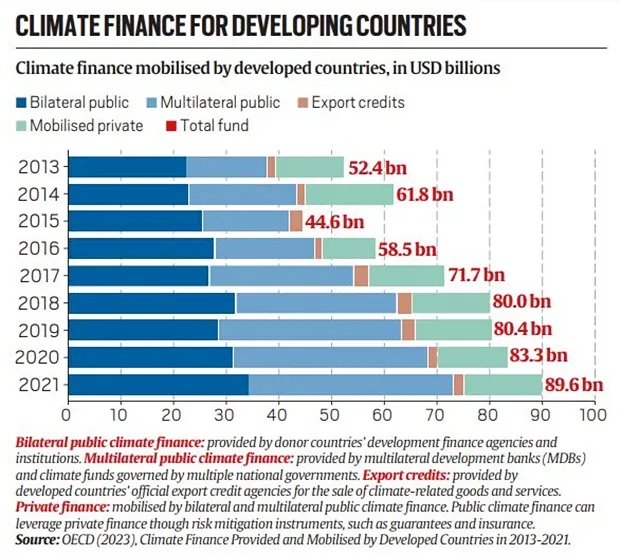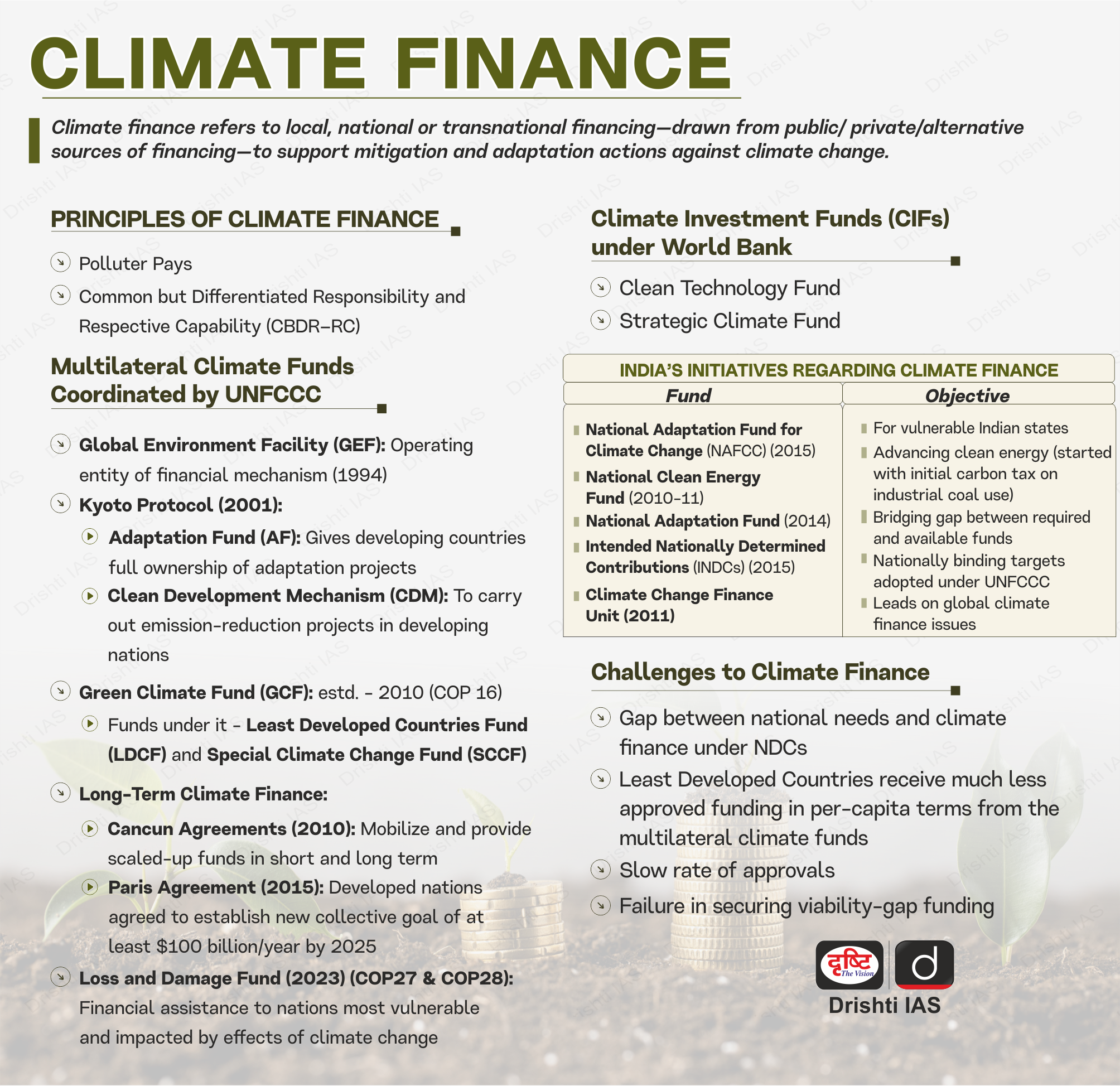Biodiversity & Environment
Bonn Climate Conference 2024
- 21 Jun 2024
- 9 min read
For Prelims: Loss and Damage Fund, Conference of the Parties (COP 28), New Collective Quantitative Goal, Fossil Fuels
For Mains: Climate Finance and its Significance, Environmental Pollution & Degradation
Why in News?
The recent climate meeting in Bonn, Germany, did not achieve significant progress in defining a new climate finance goal.
- Countries have yet to make concrete advancements on issues concerning the funding required to address the climate crisis.
What is Climate Financing?
- About:
- It refers to large-scale investments required for actions to mitigate or adapt to climate change.
- Mitigation involves reducing greenhouse gas emissions, such as increasing renewable energy and expanding forest cover.
- Adaptation involves taking action to prevent or minimise the damage from adverse effects of climate change, such as building infrastructure to protect coastal communities from sea-level rise.
- It refers to large-scale investments required for actions to mitigate or adapt to climate change.
- Current Agreed Amount for Climate Financing:
- The 1992 United Nations Framework Convention on Climate Change (UNFCCC) mandated high-income countries to provide climate finance to the developing world.
- As per Copenhagen Commitment, 2009, developed countries agreed to provide USD 100 billion per year to developing countries by 2020.
- The Green Climate Fund was established in 2010 as a key mechanism to deliver climate finance.
- The Paris Agreement in 2015 reinforced the USD 100 billion target and extended it to 2025.
- Need for Increasing Amount:
- As per the UNFCCC 2021 Report, developing countries need approximately USD 6 trillion annually from 2021 to 2030 to implement climate action plans and around USD 4-6 trillion is annually required until 2050 for a global low-carbon economy transition.
- Tripling renewable energy capacity, as agreed in Dubai, is estimated to cost USD 30 trillion by 2030 as per the International Renewable Energy Association (IRENA).
- Combining these estimates suggests an annual requirement of USD 5-7 trillion, equivalent to about 5-7% of global GDP, highlighting the escalating cost of inaction.
- India has proposed a New Collective Quantified Goal (NCQG) of at least USD 1 trillion per year, focusing on grants and concessional finance.
- Arguments for Climate Financing:
- Developing countries argue that developed nations should provide financial assistance because the rich world's emissions over the last 150 years have caused the climate problem.
- High-income countries have not yet fulfilled their financial pledges for climate finance, as majority of the finance provided is in the form of loans.
- A recent report by the OECD said developed countries met the long-standing USD 100-billion-a-year promise in 2022. However, 69% of this was provided in the form of loans.
What are Issues Related to Climate Finance?
- Contention Between Developed and Developing Countries:
- Debate Over Contribution: Under the UNFCCC and the Paris Agreement, only the 25 countries listed in Annexure 2 of the UNFCCC, along with the European Economic Community, are obligated to provide climate finance to developing nations.
- Many other countries are now economically better off than in the early 1990s, are not part of Annexure 2 like China (world’s second-largest economy), oil-rich Gulf countries, and others like South Korea.
- While developing countries refer to Article 9 of the Paris Agreement, which mandates climate finance to flow from developed to developing countries.
- Recipient Prioritisation: Developed countries advocate for climate finance to prioritise the most vulnerable nations, such as least developed countries and small island developing states, while developing countries claim that all developing nations should be eligible for support.
- Debate Over Contribution: Under the UNFCCC and the Paris Agreement, only the 25 countries listed in Annexure 2 of the UNFCCC, along with the European Economic Community, are obligated to provide climate finance to developing nations.
- Definition and Nature of Climate Finance:
- Developing countries demand clarity on the definition of climate finance, insisting it should not include development finance and caution against double-counting.
- Issues of Mitigation and Adaptation:
- The balance between funding for mitigation (reducing emissions) and adaptation (adjusting to climate impacts) is a major point of contention.
- Currently, a significant portion of climate finance goes towards mitigation projects like renewable energy.
- However, developing countries argue that adaptation is crucial for their immediate survival, given the existing impacts like rising sea levels and extreme weather events.
What is the New Collective Quantitative Goal (NCQG)?
- It is a new annual financial target proposed in COP21 in 2015 to set a post-2025 climate finance goal that developed countries must meet from 2025 onward to provide climate finance to developing countries.
- It will replace the previous commitment of USD 100 billion per year that developed nations had pledged in Copenhagen Commitment, 2009 and under Paris Agreement (2015) but failed to deliver.
- The final NCQG amount will be a key negotiation point at the COP29 summit to be held in Baku, Azerbaijan, in November 2024.
- The NCQG negotiations aim to set a higher collective amount that wealthy countries will need to mobilise annually for mitigation, adaptation, and other climate action efforts in poorer nations vulnerable to the impacts of climate change.
- Securing an adequate NCQG figure is extremely important for developing countries, as a lack of sufficient climate finance has been a major barrier to implementing effective climate plans and building resilience against global warming's effects.
UN Framework Convention on Climate Change (UNFCCC)
- It is a global environmental treaty to reduce greenhouse gas concentrations to prevent harmful human-induced disruptions to the Earth’s climate system.
- It was officially ratified in 1992. It is also referred to as the Earth Summit, the Rio Summit, or the Rio Conference.
- The Conference of the Parties (COP), a supreme decision making body of UNFCCC hold meetings annually and convenes representatives from all 197 parties to assess the progress in combating climate change.
- In 1993, India became a party to the UNFCCC, with the Ministry of Environment, Forests, and Climate Change (MoEFCC) serving as its nodal agency.
|
Drishti Mains Question: Climate change disproportionately impacts developing countries, despite their lower historical contribution to greenhouse gas emissions. Discuss the importance of adaptation finance in addressing climate vulnerabilities and suggest ways to ensure its effectiveness. |
UPSC Civil Services Examination Previous Year Question (PYQ)
Prelims:
Q. With reference to the Agreement at the UNFCCC Meeting in Paris in 2015, which of the following statements is/are correct? (2016)
- The Agreement was signed by all the member countries of the UN, and it will go into effect in 2017.
- The Agreement aims to limit the greenhouse gas emissions so that the rise in average global temperature by the end of this century does not exceed 2ºC or even 1.5ºC above pre-industrial levels.
- Developed countries acknowledged their historical responsibility in global warming and committed to donate $ 1000 billion a year from 2020 to help developing countries to cope with climate change.
Select the correct answer using the code given below:
(a) 1 and 3 only
(b) 2 only
(c) 2 and 3 only
(d) 1, 2 and 3
Ans: B
Mains:
Q. Describe the major outcomes of the 26th session of the Conference of the Parties (COP) to the United Nations Framework Convention on Climate Change (UNFCCC). What are the commitments made by India in this conference? (2021)
Q. Explain the purpose of the Green Grid Initiative launched at the World Leaders Summit of the COP26 UN Climate Change Conference in Glasgow in November 2021. When was this idea first floated in the International Solar Alliance (ISA)? (2021)








